The Comprehensive Guide to the RB25 Engine
"All you need to know about RB25DET Engine Tuning"
With the help of TMS Motorsport we are pleased to provide an all you need to know guide to tuning the popular RB25 engine.
This has to rate as one of best engines to base a tuning project on, with massive tolerance of power gains, and many tuning part options.
The Nissan RB25 engine is a 2.5-liter inline-six engine produced by Nissan that is popular among car enthusiasts. It is special for a number of reasons, including its smooth and powerful delivery of power, its reliability, the amazing array of aftermarket parts and upgrades, and its versatility.
Additionally, these factors combined with its strong performance have made it a popular choice for engine swaps in various car models.
Please note that cars fitted with the Tiptronic require a totally different approach to tuning, as the gearbox can't handle major power gains. (Tiptronic are R34 only. R33 are Normal 4 speed Autobox with snow, power and economy mode)
6 Cylinder 2,498cc 24v valve turbo engine.
RB25DE - NON-TURBO twin-cam 180 - 200 hp @ 6000 rpm,
RB25DET - twin-cam TURBO (T3 Turbo) 245 to 250 hp
The NEO head fitted from 1998 helped with emissions, it also had solid lifters and used a different cam profile.
RB25DE NEO- NON-TURBO twin-cam 219 hp @ 6000 rpm
RB25DET NEO - twin-cam TURBO 276 hp @ 6400 rpm
- Spec 1 – Has an ignition amplifier. Coil packs are marked I + E, coil pack loom is different, therefore engine loom is slightly different. There were from early 1993 to 1994, but doesn’t seem to be a hard and fast rule. The S1 also had an aluminum compressor wheel, later editions were ceramic.
- Spec 2 – Engine doesn’t have ignition amplifier. Coil packs are marked IB G +, coil pack look is different, which makes engine loom slightly different. Camshaft angle sensors were revised for a Mitsubishi CAS (early ones suffered from broken positioning teeth though so the Black CAS was introduced.)
- Spec 3 - Engine on very late R33, very few about. From late 1997 onwards. They run different camshafts, the Crank Angle sensor which went on to be used in the R34 RB25DET Neo engine.
Before you start, please have a goal in mind for your RB25 engine. TorqueCars hate to see the pick and mix approach to tuning, where various parts are just added to see what the power gains are then they are swapped out or other parts added.
So set a power goal and then look at the components you'll need to achieve this.
We would suggest that the following bhp targets of 300, 350 and 450 are good goals, as they have fairly clear upgrade paths.
Anything over 500 requires quite extensive work and a totally different range of parts so if this is your ultimate goal bear this in mind when fitting and sourcing parts
RB25 Engine tuning
Fast road camshafts usually bump the power through the rpm band, you could sacrifice a little low end torque but your top end will be higher.
Race camshafts, bump the top end band but as a result, the car will not idle smoothly and low end power nearly always suffers.
On a car used daily, it should ideally be matched your engine's power to your typical driving style.
There are tuning limits for every engine, with some being over specified and some only able to handle stock power, thankfully the RB25 block is built to handle lots of power.
However there are still power limits for stock internals, and as a few different versions of the RB25 were made it is possible to swap out parts to get the best of all worlds for your project.
We recommend you find these restrictions and upgrade to forged components to cope with the power.
What are the best RB25 mods?
- Boost Controller
- Aftermarket ECU (remapping)
- Turbo Upgrades
- Intercooler Upgrades*
- Induction kit and headers*
- Exhaust headers and catback*
- Fast Road Camshaft
*only needed if there is a restriction in your engine, these DO NOT ADD MUCH POWER, they just help improve the flow effectively releasing power.
So let's look at these mods in detail and discuss the merits and pros and cons of each of them, to help you build the ultimate modified RB25.
Raising the boost
The simple boost stage 2 hack
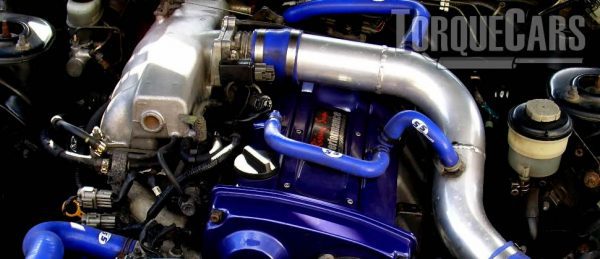
Standard Boost is 2 stage. 0.5 bar until NVCS (about 4.5k revs), then 0.7 bar until 7k rev standard rev limit. This helps maintain fuel economy and keeps it drivable in slow traffic, the stage 2 boost option is usually the first thing an RB25 tuner will do and makes an easy power gain.
The mod involved quite simply cutting the black wire on the solenoid and connecting this to ground on the car body, forcing the car to stay in stage 2 boost all the time.
There are plenty of detailed step by step instructions around in our forum, and many popular skyline forums out there.
RB25 Boost controllers
Another way to achieve higher boost at low rpm is by fitting a boost controller. You can usually set this to 0.85 bar on a standard turbo.
What is a boost controller?
In order to generate the boost, the turbo spools up and the quantity of boost provided by the actuator is controlled to some degree. To prevent the turbo from spooling indefinitely if the wastegate isn't opened, the actuator signals the wastegate to open.
In order to get a high boost, the stock boost soleniod fools the wastegate into opening later. This can be detrimental to the turbocharger will be working much harder, so you will have to fine tune the settings and not run full boost all the time!!
The same principle applies to the aftermarket boost controllers, which replace the stock soleniod, but you now have a facility which is allowing you to fine-tune the amount of boost you're able to achieve.
A decent aftermarket dash boost gauge is also recommended by TorqueCars, as it helps to know what's going on boost-wise.
The heads were pretty much the same on the R33. The NASP (naturally aspirated, non turbo) engines don't have water and oil lines to the turbo (obviously).
The map and fuel pump and injectors also have an effect on the power gains you'll make.
Extending exhaust or intake durations can alter the power band and on most engines the exhaust and intake durations do not need to match, although most cams and DIY tuners use matched pairs there are some advantages to extending the intake or exhaust durations.
Please watch our video which covers the 8 best mods for tuning your RB25 Engine. Be sure to keep up with our latest YouTube content and subscribe.
Best Engine Mods for your RB25
- Engine Tunes - engine tuning/remapping provides the most advantage in terms of cost savings, aftermarket ECUs, and piggyback ECUs are all alternatives.
- Fast road cams are one of the most significant mechanical changes, but they must be installed by someone who knows what they're doing and they are not always easy to source but you might find a local firm to regrind a stock camshaft.
- Intake and Exhaust - Note that on their own these mods will NOT ADD POWER in most cases, but they can help enhance power after other mods by removing the restriction.
- Upgrades to turbochargers and superchargers - forced induction is the most efficient approach to increase air supply, allowing you to burn more fuel and make more power. It is one of the most costly upgrades but provides the best gains.
- Head work - The goals of porting and flowing the head are to get air flowing into the engine while removing flow restrictions and turbulence.
RB25 Tuning Stages
Typical stage 1 mods often include: Fast road camshaft, Panel air filters, drilled & smoothed airbox, Intake manifolds, Remaps/piggy back ECU, Sports exhaust header/manifold.
Typical stage 2 mods often include: Ported and polished head, Fast road cam, Sports catalyst & performance exhaust, fuel pump upgrades, induction kit, high flow fuel injectors.
Typical stage 3 mods often include: Competition cam, Internal engine upgrades (head flowing porting/bigger valves), Crank and Piston upgrades to alter compression, Engine balancing & blueprinting, Adding or Upgrading forced induction (turbo/supercharger), Twin charging conversions.
Remapping the RB25
Can you tune/remap an RB25?
The map and fuel pump and injectors also have an effect on the power gains you'll make.
Alterations to the ECU timing, boost and fuel maps is best done via an aftermarket ECU, these have more control and better units allow logging and other feature absent on the OEM ECU.
(In some cases, as we find here, the factory ECU is locked flashing is not an option, so an aftermarket ECU is the route to take, and many of these will outperform factory ECU's but make sure it has knock protection and that you get it set up properly.)
Some of our members recommended the following aftermarket ECU's from their projects. You'll generally find harnesses available now for most of the aftermarket ECU options for these engines.
- Apexi
- Syvecs
- Haltech Elite 1000/1500
- Megasquirt
- LINK G4X
- IMPUL Hi Power
An aftermarket ECU is harder to setup and requires some specialist knowledge of your engine and parts you've fitted, but gives better performance and helps you optimize the timing and fuelling to a fine degree of accuracy - we suggest you go for the Link G4+ (or a G4 with an external knock control unit) or the better but more expensive Syvecs ECU (the upgraded data logging feature is extremely useful)
It will usually give you around 30% more power on turbocharged vehicles but much depends on other mods you've done and the RB25 is indeed able to handle very high power figures.
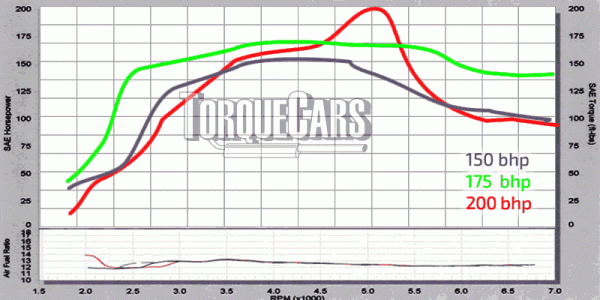
Never judge a map by the peak power figures that are quoted, you really need to see the dyno plot to see the whole story and look at the torque curve, this in our opinion is far more important than the bhp figures quoted.
In the chart above you'll see torque plots for 3 comparative tuned engines, the 200bhp map seems better, that is until you look at the graph and see it has a spike in a narrow part of the RPM range.
The Green plot shows a better map, and although it makes less peak power, it gives more power through the RPM range.
On an engine like the RB25 you want the turbo to spool up quite quickly and deliver power gains right through to the redline.
RB25 Air intake mods
Forcing fuel and air into the RB25 engine is the aim to any car tuning project.
Intake manifolds take the air from the air filter and allow it to be fed into the engine and mixed with fuel. The fewer bends this has the better you results will be.
Design and flow characteristics of the Intake manifolds can make a big effect on fuel engine efficiency on the RB25.
Induction kit benefits and drawbacks
So induction kits look to be a win-win situation. But there are certain drawbacks.
Because the filter is in the warm engine compartment, it draws in warm air with less oxygen, reducing power. Thankfully, after a mile or so, the engine compartment air temperature drops to ambient.
Installing a cold air supply pipe from outside the engine bay will assist. Engines with induction kits often gain power at high RPMs, if at all.
Installing an induction kit in isolation frequently reduces low-end power.
Because they filter less, induction kits flow better than paper elements. A paper OEM filter will always be more effective than an induction kit.
However, performance panel filters are a good compromise.
Do induction improvements always add power?
True power gains occur at higher RPMs, while many engines lose power at lower RPMs.
Are all induction kits equal?
No, the quality varies greatly. A cotton gauze filter is recommended. They frequently outperform basic filter-only kits, especially if they have a cold air feed pipe to channel cold air towards them rather than hot engine bay air, and a cold air feed pipe to channel cold air towards them.

If the OEM airbox supply is NOT severely restricted, you will experience little to no power improvement by installing one. For those who wish to improve their vehicle, an induction kit can be handy as it releases power by removing a restriction.
It is worth looking at the Apexi dual funnel Power Intake this is well designed and helps your tuned RB25 breathe more easily.
Fuelling upgrades on the RB25
The R33 GTR Fuel pump is a straight drop in and good for 500 odd BHP so becomes an obvious choice for the tuner, with the added benefit that these are quite easy to source in the used markets.
As a rule of thumb add 20% capacity when fitting an injector, this accounts for injector deterioration and affords you some spare capacity should the engine need more fuel.
The standard fuel injectors usually hit the maximum at around 350BHP. GTR ones don’t fit, unless modified and you use GTR injector ballast (different feed and impedance) so most people go to 555cc injectors, but every capacity and option is available to suit all power levels and fuel types.
TIP- Increasing the fuel pressure will effectively overdrive the injectors and help keep them in the optimum fuel delivery range.
Intercooler upgrades for the RB25
Turbos have issues with the cold intake charge being near to the hot exhaust temperatures. Remember that even supercharged engines benefit from an intercooler since the compression of air causes a large heat buildup.
Compressing air produces heat, as every tire pump user knows. We know from chemistry and physics that cooler air holds more oxygen. Why is this so? The more oxygen you have, the more gasoline you can burn, increasing the car's power output.
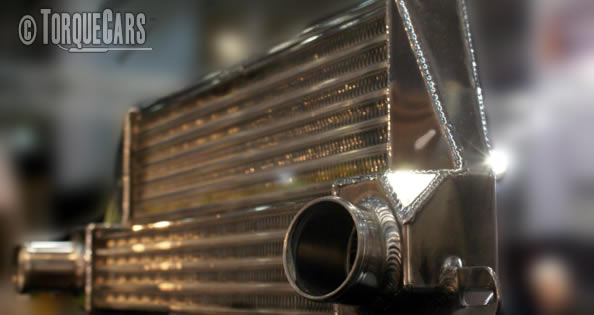
What does an RB25 intercooler do?
An intercooler is a radiator that cools the intake air charge before it enters the engine. Install an intercooler in front of the radiator to take advantage of the cold air.
Front mounted intercoolers "FMIC" lie in front of the radiator at the front and provide better air cooling than top mounted or side mounted intercoolers.
An effective intercooler design may free up 5-10% power and withstand heat soak for longer!
All turbocharged automobiles will benefit from an uprated intercooler. Remember that you want to suck as much air into the engine as possible, therefore a restrictive intercooler core will reduce power.
Intercooler design
The internal flow characteristics and the cooling fins are what make an intercooler work. The fins should have the most surface area, while the interior core should have few tapering bends and no turbulence-causing internal welds.
However, the advantages of having a top quality intercooler installed outweigh the minor loss of airflow inherent in a properly constructed intercooler.
3 liters intercooler capacity per 100bhp is a good rule of thumb. Not pretty, but it appears to work well for vehicles with 150-400bhp!
In practice, a huge intercooler may obstruct airflow, thus choosing the right size is critical (this is something that can be discussed in more detail in our forum.)
TorqueCars expects a pressure reduction of 0.5 to.9 psi for a 15PSi boost level, with certain applications losing up to 1.3psi. (Losing pressure comes from reducing air temperature, so don't blame the intercooler design for the full loss of pressure.
Weight is usually a concern for most project car builders, and it should be noted that many aftermarket intercoolers are both lighter and perform better than original units.
Generally, a larger intercooler provides greater cooling, but it also causes more drag on the intake. The greater drag must be evaluated against the added cooling. The longer the air stays within the intercooler, the colder it is.
With a temperature decrease of 35C-40C, an efficient intercooler design often gains 5-10% power over OEM with a temperature drop of 35C-40C, depending on the ambient temperature.
Even huge efficient intercoolers will eventually succumb to heat soak. Intercoolers begin to warm up during prolonged durations of high boost driving and become less effective.
RB25 Turbo upgrades
We've seen tuners spending a lot of money on turbocharger upgrades on the RB25 only to see the engine throw a rod on its first outing after it's been enthusiastically driven.
This is most usually down to issues with the mapping, and we cannot stress enough the importance of getting your car set up by someone familiar with your mods and the RB25 block.
Bigger turbochargers commonly suffer no power at low rpm, and small turbochargers spool up more quickly but won't have the peak end engines power gains.
We are pleased that the choice of turbo chargers is always evolving and we now see variable vane turbo chargers, allowing the vane profile is altered according to speed to lower lag and increase top end torque.
Twin scroll turbo chargers divert the exhaust flow into 2 channels and feed these at differently designed vanes in the turbo. They also improve the scavenging effect of the engine and tend to spool up more quickly.
It is not unusual that there's a restriction in the air flow sensor (AFM/MAF/MAP) on these engines when considerably more air is being drawn into the engine.
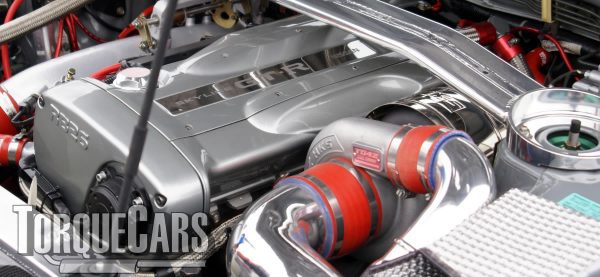
You'll see that 4 bar air sensors coping with quite large power gains, whereas the OEM air sensor sapped bhp and torque at a much lower level.
What are the best turbo upgrades and what power figures do these support, mention a bolt on swap and also list the more complex turbo upgrades and hybrid options.
R34 GTT turbo is a little bit bigger. My preference would be 3037 Garrett or HS 2835 for around 400 ish bhp, more than that gets a bit pointless on the road !
You may need to improve your exhaust if the current exhaust is actually creating a restriction in flow.
RB25 Camshaft Upgrades
Race camshafts, bump the top end band but as a result, the car will not idle smoothly and low end power nearly always suffers.
Note that when it comes to camshafts the one providing a longer duration isn't always the performance option, rather it's better to have a larger lift this will improve the valve curtain area and allow more air in. Make sure your higher lift will work on your piston choice.
With variable valve timing, the duration of a cam becomes very much a minor consideration. There are a range of camshafts available, but we would encourage you to speak to a specialist and discuss your head flow characteristics and general setup to facilitate the best cam option for you RB25 project.
Extending exhaust or intake durations can alter the power band and on most engines the exhaust and intake durations do not need to match, although most cams and DIY tuners use matched pairs there are some advantages to extending the intake or exhaust durations.
On a car used daily, it should ideally be matched your engine's power to your typical driving style.
There are tuning limits for every engine, with some being over specified and some only able to handle stock power, thankfully the RB25 block is built to handle lots of power.
However there are still power limits for stock internals, and as a few different versions of the RB25 were made it is possible to swap out parts to get the best of all worlds for your project.
We recommend you find these restrictions and upgrade to forged components to cope with the power.
You may need to improve your exhaust if the current exhaust is actually creating a restriction in flow.
RB25 Exhaust headers and catback upgrades
On most factory exhausts you'll see your flow rate is ok even on modest power gains, but when you start pushing up the power levels you will need to get a better flowing exhaust.
So unless the current exhaust is restricted you WILL NOT GAIN POWER from an upgrade, especially if you only do a catback upgrade.
Sports exhausts generally help improve air flow out of the engine but avoid an exhaust that is too large or you could very well end up with a reduced flow rate. So generally speaking, keep to 1.5 to 2.5 inches as a rule of thumb.
Common exhaust restrictions are in the pollution control filters/catalysts installed, so adding a faster flowing performance catalyst removes the restriction.
We note that performance cats perform similarly to decats and have the added benefit of keeping your car street legal, as decats or catalyst removal is illegal in most territories for road going cars. Although in some regions even replacing a working catalyst is frowned upon.
Looking over the exhaust you could fit a 75mm downpipe which improves Torque and BHP by up to 35lbft and 25bhp in some cases. Then taking off the catalyst (an off road mod in most countries) will give another 10 bhp.
Weak spots/problems with the RB25 engine?
Running more than 0.9 bar boost on standard ceramic turbo causes premature turbo failure.
Oil cooling is required and highly recommended on spirited use, as these run quite hot so keep an eye on the oil temps.
Oil surge on high speed cornering leading to bearing failure (People often overfill standard engine by about ½ litre or more when on track, up to the H on the dipstick which is about 10mm over the full line)
- After 300 bhp you'll need an upgraded ECU.
- At 320-340bhp and greater, you should uprate the turbo, head gasket, clutch, airflow meter, and injectors.
- Pistons are generally good for 500bhp.
- The RB25 block can be rebored from the standard 86mm to 86.5mm or 87mm.
The standard RB25 crank does not fit 100% over the oil gear on the oil pump. Most owners will opt for a crank collar fitted to the crank, (you may need to grind the crank to allow the collar to fit) but by doing this it will allow for better flow and longer lasting oil pumps and reduces wear and tear.
Also if you are drifting or frequently highly revving the motor there is an issue related to having too much oil in the head and this causes the crank bearings to fail.
To help with this issue you can remove the two 1.5mm oil restrictors in the middle of your block between cylinders 3 and 4 and get 1.1mm restrictors fitted (this will make the flow to the head a little bit less and keep the oil where it needs to be.)
Also add an oil drain to the back of the head and connect that to your turbo drain side to allow more oil to flow out of the head
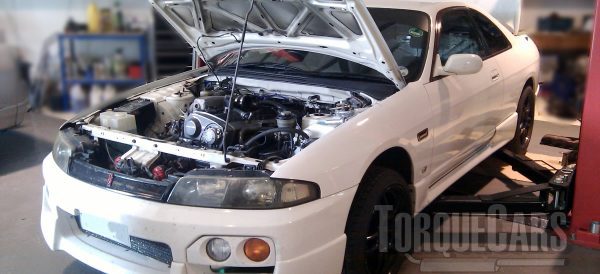
Please help us to complete this article, use the feedback box below if you spot any errors or have any tips or comments to pass on to other RB25 engine tuners.
For more information on Tuning your car please join us in our friendly forum where you can discuss Nissan RB25 options in more detail with our Nissan RB25 owners. It would also be worth reading our unbiased Nissan tuning articles to get a full grasp of the benefits and drawbacks of each modification.
Please help us improve these tips by sending us your feedback in the comments box below.
We love to hear what our visitors have got up to and which mods work best for them on each model of car. We use your comments and feedback to improve the accuracy of these tuning guides which get regular updates and revisions.
Please Check out my YouTube channel, we're regularly adding new content...
PLEASE HELP: I NEED YOUR DONATIONS TO COVER THE COSTS OF RUNNING THIS SITE AND KEEP IT RUNNING. I do not charge you to access this website and it saves most TorqueCars readers $100's each year - but we are NON PROFIT and not even covering our costs. To keep us running PLEASE Donate here
If you liked this page please share it with your friends, drop a link to it in your favourite forum or use the bookmarking options to save it to your social media profile.
Feedback - What do You Think?
Please use our forums if you wish to ask a tuning question, and please note we do not sell parts or services, we are just an online magazine.
Help us improve, leave a suggestion or tip
Please watch this video and subscribe to my YouTube channel.
3 Responses to “Tuning the RB25DET engine”

 Click to accept YouTube Cookies & Play.
Click to accept YouTube Cookies & Play.
Hi im doing a RB25DET build looking to make 450 hp, ive made my minde on 750cc injectors and making it a topfeed to 11mm fuel rail, but i dont know what the bottom size of the injectors should be and WHAT injectors to order? Please help me with this tune,
Hi, great article.
When mentioning the rb25 running hot you might mention that not removing coil pack cover on head gasket can result in heat damaged coil packs on higher km/m engines.
I’m currently building ’99 r34 rb25 neo non turbo. Currently hovering around ~235 bhp. A modified air intake, cat back exhaust and some efforts in weight reduction have been done. ECU upgrade soon.
If you would like to follow me on ig @jtr_tame you follow my build journey.
it was great it had everything you need to know about the RBs